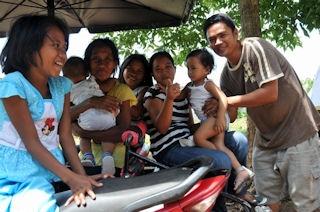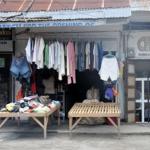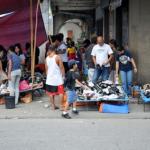Ukay-Ukay
Ukay-Ukay, it is the Filipino adaptation of a "flea market" and one of those typical features from the Philippines. It began more than thirty years ago and in a short period of time became the best bargain sensation in the country, from rags to riches, a shoe-string enterprise, born out of necessity and grown into a lucrative fashion industry.
Ukay-ukay (in short UK) is actually gouging in a pile of run down clothes, the word is derived from the Filipino phrase 'halukay' which literally means "digging" or "make a mess." Nowadays it is a term used for places that sell old clothes, bags, shoes and other pre-owned goods at very low prices. In a poverty stricken country that is often hit by calamities, in times of need, ship-loads of second-hand and discount garments and other relief goods from various parts in the world came in, as forms of support to the people of the Philippines. But for many reasons the goods piled up and were exchanged to tradesmen who, in turn sold the clothing to the general public. The first resale stores were known as "wagwagan" because the dust had to be shaken off ("wagwag") from the worn apparel. Originally the relief-for-sale stores only carried used wardrobe, later on shopkeepers began to take in other items like toys and household goods.
Clothing is one of the elementary necessities in life, in various parts of Mindanao even the most basic needs are out of reach for the underprivileged, looking for good value is a daily cause. Getting some decent attire to wear is very difficult for a low income family, for them ukay-ukay is the answer to their problems, at least they can buy a fair outfit for any amount of money in hand. But recession has gained its foothold in today's economy, ukay-ukay is not exclusive to the less fortunate anymore, even the most stylish fashionistas are scrounging into the piles of clothing, looking for that perfect vintage piece for next to nothing. However, as well for the poor and the prosperous, poking into that pile of hand-me-down fashion trying to find that something to-die-for comes with a certain price. Vendors are pouring some kind of disinfectant on their already musty-smelling merchandise that gives it a striking stink, the place often has a foul odor that whiffs like an over sized mothball. Shoppers must be capable to withstand this migraine-causing scent, they need a lot of patience and also should be absolutely persevering and relentless in their rummage from stall to stall for timeworn threads, one will be never alone in it's search for that unique item.
Some bargain hunters, consider it like fun when hauling through heaps and racks of passed down textile that is not always in the best condition and clean. For a few it is the equivalent of treasure hunting, for many it is an ongoing quest for affordable clothing and an inevitable part of common life. Browsing through your local thrift shop has not only financial advantages, you can get authentic pieces that are hard to find anywhere else. Because there will be less production, it is environmentally friendly and it is humanitarian since it reduces child and slave labor in the manufacturing countries. Ukay-ukay is big business, many outlets and makeshift-stalls can be found all over the nation, there is no city, municipality, barangay or barrio without it and any local public market or village fair will not be complete if it does not have an "ukay-ukay" section. The barter has also provided a viable livelihood to a large number of families, with a minimal amount to invest they started off retailing pre-loved regalia in their own yard or house trying to turn trash into treasure. Over the years this Segunda Mano phenomenon became socially accepted and very popular to scores of cash-strapped Filipinos from all walks of life and has risen from a local market operation into a thriving trade. It offers fashion minded individuals the opportunity to shop for signature clothes with a rock-bottom bill.
Still, the ukay-ukay will benefit the poor and lower middle class most, it will allow them to bargain for cheap wear and gives them the chance to get hold of mannerly clothing that otherwise would end up as cleaning material, meeting its final destination at a garbage site. These days more and more people want or need to dress for less and are joining the ukay-ukay craze. So, dig in and dear to wear, ukay-ukay is okay, it is a number-one shopping experience for second-hand happiness.
 ThingsAsian
ThingsAsian



















